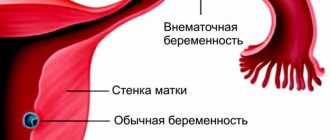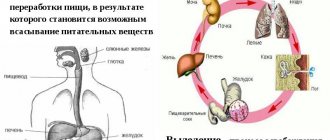If the female body perceives the beginning of pregnancy as something alien or even dangerous, a miscarriage is most often provoked. As a rule, everything happens in the very early stages of development, during the first 12 weeks, which is why some patients lose the fetus without even suspecting their own pregnancy. It is extremely important to know how to distinguish a period from a miscarriage in order to promptly diagnose a problem or disease, as well as prescribe the correct treatment under the guidance of a doctor. This is especially true for patients planning pregnancy and the birth of a healthy child in the future.
The difference between menstruation and miscarriage
In terms of external manifestations, a miscarriage is practically no different from menstruation, which begins after some delay. From the moment of fertilization of a mature egg, at first, no special changes are observed in the female body. The only nuance may concern. In this case, early miscarriage is caused by more intense bleeding and uncharacteristic painful sensations in the abdominal area. If the discharge lasts the usual number of days for menstruation, the patient may not suspect anything and ignore the need to visit a doctor.
The main signs of a miscarriage or spontaneous termination of pregnancy relate to an increased abundance of discharge, its onset with some delay (just a few days), as well as painful sensations in the lower abdomen that are not typical for normal menstruation.
As a rule, fetal rejection in the early stages signals the unpreparedness of the reproductive systems for full gestation and the birth of a healthy baby. On the other hand, the situation may be due to the fact that the female body is trying to independently get rid of an abnormally developing or sick fetus.
When should you see a doctor?
Doctors are not always able to accurately determine early pregnancy loss. Blood tests, imaging and other diagnostic procedures help them with this.
Women who experience early pregnancy loss usually do not require treatment.
After bleeding, you should consult a doctor at any stage of pregnancy
However, you should contact your doctor if any bleeding occurs after a positive pregnancy test result. The same should be done if very severe or painful bleeding develops that does not stop.
You should also contact your doctor or fertility specialist if:
- several miscarriages occur at the stage of chemical pregnancy;
- attempts to conceive a child do not work for longer than 12 months.
You should also contact your doctor if you develop symptoms of endometriosis, such as:
- pain during or after sex;
- pain in the intestines;
- painful bowel movements;
- Digestive problems such as diarrhea, bloating, constipation or nausea during your period.
How to find out if a miscarriage has occurred
Pain that is transmitted from the lower abdomen to the lumbar region, as well as uncharacteristically abundant vaginal discharge, which is distinguished by a more saturated red color or even with a brown tint, can help to recognize a miscarriage in the early stages.
In the bleeding itself, tissue fragments may be observed, which make it clear that a miscarriage has occurred. Spontaneous termination of pregnancy can also be determined by vaginal exit, which was preceded by pronounced abdominal pain. The clot itself somewhat resembles a burst bubble filled with blood. After determining a miscarriage, you must consult a doctor and undergo additional examination. Only the attending physician will be able to correctly assess the current situation, prescribe additional tests and recommend treatment to ensure the possibility of a successful pregnancy in the future.
The second important point concerns a thorough examination of the patient and determining the need for cleaning, since particles of the endometrium and the fetus itself may remain inside, provoking dangerous inflammatory processes and complications in the organs of the reproductive system.
Symptoms of the onset of a miscarriage may also relate to a general deterioration in the patient’s condition, the appearance of headaches and dizziness, and the manifestation of muscle cramps. Signs of a septic type miscarriage (infection of the contents of the uterus) relate primarily to the presence. Special attention should be paid to spasmodic pain in the abdominal area, as well as painful sensations of cold (chills when body temperature rises).
In any case, you should undergo an examination by a gynecologist, since he will help to correctly determine whether there was a miscarriage or whether the pregnancy was saved. For this purpose, a specialist can direct you to undergo:
- Ultrasound, which allows you to confirm or refute the presence of a fetus in the uterine area;
- Vaginal examination to determine the degree of dilation of the cervix;
- Analyzes of hormonal levels.
If a miscarriage has been diagnosed, but the fetus is not fully expelled, the patient needs cleaning.
How does a miscarriage occur?
A miscarriage is considered to be an interruption of pregnancy before 22 weeks or when the fetal weight is less than 500 g, regardless of the presence or absence of signs of fetal life.
A miscarriage is the premature exit of the fetus from the mother's body. There are two options for this process, which directly depend on the timing of pregnancy.
The first option is a miscarriage by type of rejection. This type of miscarriage is observed in the first trimester of pregnancy as a result of an immune conflict between the mother and fetus. As a result, the functions of the future placenta are disrupted and antibodies are produced to the cells of a “foreign” body. In this case, the chorion is destroyed, and the fertilized egg is expelled from the uterine cavity. The process is accompanied by bleeding of varying degrees - most often it is heavy bleeding.
The second type of miscarriage occurs according to the type of birth, and is observed in the second and third trimester of pregnancy. The main role in this variant is played by a change in the tone of the uterus - a significant increase in the tone of the uterine muscles or insufficiency of the uterine closure apparatus. In this case, contractions, opening of the cervix and the birth of the fetus are observed.
During miscarriages in the first trimester, nagging pain occurs in the lower abdomen, spotting red-brown discharge appears, bleeding may appear, and sometimes the urge to urinate and defecate. In this case, the fetus completely or partially leaves the uterine cavity with blood clots.
At later stages, a miscarriage occurs as a premature birth with contractions and cramping pain, the release of amniotic fluid and the fetus with its membranes, in whole or in part.
Please tell me, is it normal that I gained virtually no weight during the first months of pregnancy? I don’t know exactly what my weight was immediately before, but during the year before that it fluctuated between 53 and 54 (I’m 22, height 168,
If you notice the appearance of bloody discharge in the early stages of pregnancy, consult your doctor immediately, as there is still a chance of continuing the pregnancy until heavy bleeding occurs. If there is excessive bleeding, hospitalization is necessary
Source
Causes of miscarriage
The detected spontaneous termination of pregnancy is caused by a disrupted process of development of the pregnancy itself. No less serious reasons for spontaneous termination of pregnancy can be:
- genetic disorders in the development of the fetus itself;
- infectious diseases of various types;
- diabetes in a pregnant woman;
- disturbances in the hormonal balance of the body;
- problematic functioning of the thyroid gland;
- diseases of the uterus and cervix.
In medical practice, a miscarriage can be called not only the spontaneous termination of pregnancy in the female body during the first few weeks of its course. This applies to all cases of fetal rejection before the 22nd week of pregnancy itself. The weight of the fetus does not reach 500 g. It is in such cases that medical assistance is not able to save the child, but all efforts are directed towards preserving the health of the mother.
When the body decides to get rid of the pregnancy itself, a miscarriage occurs. Most often this happens in the first twelve weeks, that is, in early pregnancy.
According to statistics, about twenty percent of women lose a child without knowing that they are pregnant.
In gynecology, a miscarriage is considered to be up to twenty-two weeks, since children born after the twenty-second week, but prematurely and weighing 500 grams, can be saved with modern medical means. However, with a weight of less than five hundred grams, there is no chance of saving the child.
Classification of miscarriages
To study this issue in more detail, it is necessary to consider the classification of miscarriages. So, doctors divide miscarriages into the following types:
- Threat of miscarriage - characterized by bloody discharge and contraction of the uterus. Most often you can stop it while maintaining the pregnancy.
- Incipient abortion - manifests itself in the form of heavy bleeding and cramping pain. In this condition of a woman, pregnancy does not continue.
- Incomplete abortion - occurs when the fetus is partially rejected.
- Complete abortion - the fetus is completely rejected, while the uterus contracts, and the bleeding gradually stops.
- A regular miscarriage is a situation in which an arbitrary termination of pregnancy occurs with rejection of the fetus for the third time.
The septic type of miscarriage is put into a separate category. This type of voluntary abortion occurs due to infection of the contents of the uterus.
Symptoms of septic miscarriage should not be confused with menstruation:
- unpleasant odor from vaginal discharge;
- bleeding;
- lower abdominal pain;
- febrile general condition.
View gallery
Ignoring this condition is extremely dangerous. You need to call the ambulance service immediately.
What are the signs to distinguish a miscarriage from an early period?
In the very early stages, when a woman does not know that she is pregnant and no symptoms tell her about this condition, she waits for the onset of menstruation and notices some delay. After a few days, your periods seem to begin, however, they are more abundant than usual, and they may be accompanied by more intense pain.
In some cases, early miscarriage results in only moderate pain in the lower abdomen and heavy bleeding. A woman may well not see a doctor if the bleeding stops within a reasonable time. If there is heavy bleeding that lasts several days, she will probably go to the doctor.
Thus, if the woman is not alerted by heavy bleeding and some delay, then another important symptom of early miscarriage is abdominal pain. indicates that the woman’s body is not ready for the normal development of the baby. Perhaps both parents have some health problems. This needs to be accurately determined and treatment started and strengthened, then next time the baby will develop healthy. The body tries to get rid of the unhealthy fetus on its own.
From the lower abdomen, pain can spread to the lower back; the pain is also characterized by its frequency. The threat of early miscarriage is also indicated by vaginal discharge, which may be reddish or have a brown tint. In this case, it is highly advisable to consult a doctor; it is quite possible that a miscarriage can be avoided.
If the discharge is small, then the likelihood of maintaining pregnancy is much higher than with heavy bleeding. If tissue fragments are also observed during bleeding, this is evidence of a miscarriage.
Sometimes this kind of delayed menstruation causes very noticeable pain, and the process ends with the release of a blood clot, reminiscent of a burst bubble of blood. There is every reason to claim a spontaneous miscarriage. This manifestation is usually alarming and frightening if it is noticed for the first time. This is a correct assessment of the situation, because if a blood clot is noticed, you should definitely inform your doctor about it. You should undergo an examination to clarify what happened. In addition, you should know exactly whether a woman needs cleaning.
Pregnancy is a long-awaited event for every woman. But sometimes, with a long delay, bleeding may appear. How to determine the nature of such bleeding? Normal menstruation or miscarriage in the first months of pregnancy? It is necessary to understand the differences between these processes.
Menstruation after a long delay may be a miscarriage
Recovery after a miscarriage: how to survive it
If a miscarriage was diagnosed in the early stages of pregnancy, this is not a death sentence. Most women recover successfully after a spontaneous abortion and retain the ability to bear and give birth to healthy children. This is possible under the guidance of an experienced doctor.
Rehabilitation includes:
- A thorough examination, identification and treatment of diseases that could lead to a miscarriage. This applies to diseases of the reproductive system and general health problems.
- Strict control of one’s own condition on the part of the woman. If unusual vaginal discharge appears during or after treatment, as well as other symptoms, do not postpone a visit to the gynecologist.
- Establishing a proper lifestyle, work and rest schedule, and physical activity.
- Proper and balanced nutrition.
- Calmness and positive attitude. Confidence in success is very important.
Sanatorium-resort treatment in special medical institutions will be of great benefit for restoring health and reproductive function.
Early miscarriage is common, but this is not a reason to ignore the problem.
It is necessary to find out what is the cause of spontaneous abortion and eliminate it. An experienced gynecologist can help with this.
Pregnancy is a long-awaited event for every woman. But sometimes, with a long delay, bleeding may appear. How to determine the nature of such bleeding? Normal menstruation or miscarriage in the first months of pregnancy? It is necessary to understand the differences between these processes.
Menstruation after a long delay may be a miscarriage
The difference between miscarriage and menstruation
According to statistics, about 13% of women, unaware of pregnancy, lose a child in the first weeks after conception. A miscarriage is an interruption of pregnancy within 6 months of pregnancy that occurs spontaneously. Having babies after 22 weeks of pregnancy means premature birth. In this case, the baby can still be saved. The most dangerous periods are considered to be the first 12 weeks of pregnancy.
. But sometimes spontaneous miscarriage is possible immediately after conception and fertilization. Then the woman has no idea about the interesting situation, continuing to live an ordinary life.
It is very difficult to independently determine whether a miscarriage has occurred. Especially if the bleeding began exactly at the scheduled time of menstruation. If the delay occurs for a couple of days, then we can already talk about successful fertilization of the egg and spontaneous abortion. In this case, menstruation occurs with severe pain, and the discharge becomes more abundant. The duration also often increases. In this case, the color of menstruation becomes brighter (scarlet, sometimes brown). After an early miscarriage, blood clots (remnants of the fertilized egg) are often present in the discharge. But the woman’s condition remains satisfactory, and she has no reason to visit a gynecologist.
With spontaneous abortion, pain may appear in the lower abdomen, which often radiates to the lumbar region. There are cramping aching pains, deterioration of health, weakness, nausea, dizziness. The presence of such symptoms is not at all necessary, but if they appear, it is better to consult a doctor immediately.
The appearance of any suspicious vaginal discharge (especially red and brown) is an alarm bell for any woman. If you consult a doctor in a timely manner and prescribe supportive medications, you can save your pregnancy. And also reduce the risk of developing inflammatory processes in the uterus.
The onset of a miscarriage is associated with the unpreparedness of the female body to bear a healthy child. Nature provides natural selection, and if in this case the fetus is not viable, then spontaneous rejection of the embryo begins.
In the first weeks after conception, a miscarriage is similar to a normal period.
Symptoms of miscarriage
You can find out about pregnancy using a test at least in the third week, when your period should begin. Before this, a woman can only guess about her condition. But the time of onset of menstruation is considered the most dangerous for pregnancy; it is during this period that a miscarriage can occur in the early stages. A woman, being pregnant, may perceive spotting as the beginning of her period, but in fact these will be the first signs of a miscarriage.
To distinguish menstruation from spontaneous abortion, you need to know the symptoms of a possible abortion, namely:
- Bloody discharge, the appearance of which does not coincide with the period of menstruation. This may include spotting mixed with blood, bleeding, blood clots mixed with tissue. In any case, you need to consult a doctor who, using an ultrasound, can determine the cause.
- Severe pain in the lower back.
- Pain and cramping in the lower abdomen.
There are cases when the fetus freezes in the womb and bleeding does not occur. A frozen pregnancy is not accompanied by pain or discharge, because the fetus is not rejected. This condition can threaten a woman’s life, because the contents of the uterus become infected and if no action is taken, blood poisoning will occur and the woman will die. Only an ultrasound will help determine the death of the fetus.
In some cases, during a frozen pregnancy, fetal rejection still occurs.
Then the following symptoms appear:
- vaginal discharge with an unpleasant odor, its color and quantity may change;
- severe pain and cramps in the lower abdomen;
- fever and high temperature.
Very often these symptoms are accompanied by heavy bleeding.
There is also such a thing as the threat of miscarriage. This diagnosis is made when rejection and expulsion of the fetus have not yet occurred, but there is a high probability of this. Usually, the threat of losing a child appears when the uterus is toned.
You can distinguish a threat from the upcoming menstruation by the following symptoms: cramping pain in the lower abdomen in the middle of the cycle or when menstruation is delayed, which is accompanied by brown or bloody discharge.
In the early stages, spontaneous abortion may go undetected if the woman's uterus is completely open. In this case, periods simply begin with a delay, they become heavy, accompanied by severe pain in the lower abdomen and lower back.
Every woman values her pregnancy, so any painful sensations or specific discharge from the genital tract should alert her.
How to determine a miscarriage
Outwardly, it is almost impossible to distinguish between menstruation and miscarriage, especially if there is a delay of several days. An ultrasound at such a time will be uninformative. The fertilized egg (or its remains) is too small for such a device. When examined, the gynecologist also cannot say with certainty whether there was a pregnancy. Both at the beginning of menstruation and with successful fertilization, the uterus slightly increases in size, which makes it impossible to accurately determine the cause of the bleeding.
To determine a possible pregnancy, you can use two alternative methods: a blood test for the level of the “pregnancy” hormone and changes in the basal temperature chart during the menstrual cycle.
When a fertilized egg attaches to the uterine cavity, a woman’s body begins to produce a certain hormone - chronic human gonadotropin. Pregnancy tests work when the value of this indicator increases. In the first weeks, the level of hCG is quite low, and it is almost impossible to determine it by urine analysis. A blood test is used to diagnose pregnancy. Even after a spontaneous miscarriage, hCG in the blood remains elevated for another 10 days. And based on the test results, you can find out whether conception has occurred.
Some women measure their basal temperature during the menstrual cycle for several months in a row to ensure successful fertilization. Using the parameter graph, you can find out whether conception has occurred and whether a miscarriage has occurred. The temperature values during fertilization of the egg change significantly, so by comparing the previous graphs, we can conclude whether there was an interruption. During pregnancy, basal temperature rises in the last phase of the menstrual cycle.
Temperature fluctuations will help determine whether there has been a miscarriage
How is a miscarriage different from a period?
Menstruation is not the most pleasant period for a woman, but most of all its beginning upsets those who passionately dream of becoming pregnant. However, bleeding is not always caused by the usual procedure of endometrial rejection; sometimes it accompanies the termination of a pregnancy that has just begun. You can find out for sure whether a miscarriage or menstruation was caused by spotting. There are several methods for this.
Menstruation and miscarriage are different physiological processes, but they are accompanied by similar symptoms.
Menstrual bleeding is part of the natural female cycle. Every month the body prepares to conceive a child; this process is controlled by hormones. The internal cavity of the uterus is lined with a special layer - the endometrium, designed to secure the fertilized egg and subsequently nourish the embryo. If fertilization of the egg does not occur (or there is no ovulation), the endometrium dies and is removed from the uterus along with the remnants of small blood vessels formed during the cycle. Outwardly, it looks like bloody discharge from the vagina, and is often accompanied by pain. This process is called menstruation (or menstruation).
Miscarriage is a term that refers to the spontaneous termination of pregnancy in the early stages (before 22 weeks). If conception occurred recently, then externally, fetal rejection is almost no different from normal menstruation.
It is also accompanied by pain and bleeding. The fertilized egg is still too small to be seen among the blood and clots.
Miscarriage occurs for various reasons; for successful conception and pregnancy they must be identified and eliminated.
There are practically no visual differences between early miscarriage and menstruation, but methods for recognizing them still exist.
External signs by which one can assume the true cause of bleeding are quite conventional:
- A delay in menstruation can be caused by both the onset of pregnancy and hormonal imbalance.
- Bleeding in the event of a miscarriage is longer and more profuse.
- An unusual color or smell of blood or the presence of clots may indicate a miscarriage. During menstruation, these signs are not observed.
- Menstruation and miscarriage differ in the nature of pain. With a spontaneous abortion, unpleasant sensations may resemble contractions and radiate to the lower back. Menstruation is often accompanied by nagging discomfort in the lower abdomen.
Such symptoms do not allow one to reliably determine whether bleeding was caused by menstruation or a miscarriage. To find out exactly, other methods will be required.
It is almost impossible to distinguish spontaneous abortion from menstruation based on external symptoms, especially if it occurs at a very early stage. Ultrasound examination in this case is also uninformative - for the device these processes look the same. The size of the fertilized egg at this period is still too small and does not allow it to be seen.
Determining whether a miscarriage or menstruation is the cause of bleeding is available thanks to the development of laboratory diagnostics.
There is a sign that allows you to find out with a high degree of certainty whether there was a pregnancy. It is indicated by the presence of a special hormone in the woman’s blood and urine – human chorionic gonadotropin (hCG).
It is on its detection that the action of all tests is based - the second strip appears if there is a sufficient concentration of this substance in the urine.
The hCG hormone begins to be produced approximately a week after implantation of a fertilized egg into the endometrium, its content in the blood rapidly increases until 11-12 weeks, and then begins to decrease. A high concentration of human chorionic gonadotropin in a woman’s blood and urine persists for several days after a miscarriage. This is what makes it possible to distinguish it from menstruation.
Therefore, the most accessible way to recognize an early miscarriage is to take a pregnancy test. When the bleeding is just menstruation, only one line will appear. And if it is caused by spontaneous abortion, the second one will be clearly or faintly visible.
A more reliable method is to determine hCG using a special blood test. A reliable result can be obtained within about a week after the start of bleeding. After a miscarriage, the level of the hormone decreases, and after a few days it is already difficult to detect.
If your period is late, it makes sense to take a test right away. Modern means detect an “interesting situation” on the very first day of delay. If the result is positive, if bleeding begins, it will be clear that the cause is not due to menstruation. Knowing this, you can promptly seek medical help.
In addition, one of the ways to recognize conception is to measure basal temperature and keep a graph of indicators . In the case of fertilization of the egg, the value increases noticeably, which also makes it possible with some degree of confidence to distinguish an interrupted pregnancy from menstruation in the event of bleeding.
According to statistics, every woman experiences an early miscarriage at least once during her life, mistaking it for normal menstruation. The symptoms and signs of these processes are almost identical. The reasons for terminating a pregnancy that has just begun are different:
- infectious and inflammatory diseases (gynecological or general);
- hormonal disorders;
- Rh conflict and other immunological factors;
- stress;
- improper fixation of the embryo in the uterus;
- high physical activity;
- taking medications, including herbal ones;
- genetic abnormalities in fetal development;
- bad habits, unhealthy diet, coffee abuse;
- sexual contact, trauma;
- intoxication;
- overweight or underweight;
- insufficient restoration of the uterus and the body as a whole after a previous birth, abortion or miscarriage.
Fetal rejection in the first weeks after conception usually does not pose a health threat, but there are exceptions.
If menstruation began exactly on time, there is a high probability of spontaneous abortion. You can understand that bleeding is the beginning of a miscarriage by a number of signs:
- severe cramping pain radiating to the lower back;
- brown color of blood, an abundance of clots in the discharge;
- positive pregnancy test.
In this case, even if bleeding began without delay, you should consult a doctor to receive an accurate diagnosis and the necessary medical care.
Fetal loss may progress like a normal period. It is especially difficult to feel the difference if menstruation is heavy, painful and accompanied by the release of blood clots.
If you have the slightest suspicion of other causes of bleeding, you should consult a doctor. A miscarriage (even at a very early stage) poses a danger to a woman’s reproductive health and requires rehabilitation under the supervision of a specialist.
If a woman is sure that she is pregnant, or suspects this with a high degree of probability, she needs to be especially attentive to the symptoms. Spontaneous abortion does not happen instantly; the process takes some time. Therefore, if you go to a medical facility at the first signs (pain, bleeding), there is a chance to save the embryo.
In addition, if there is a threat of fetal loss, it is very important to follow the following recommendations:
- avoid physical activity, heavy lifting;
- If possible, maintain bed rest;
- refuse sexual contacts;
- stay calm, avoid stress.
As a rule, if there is a threat of fetal rejection, hospitalization is recommended. In a hospital setting, the necessary examinations will be promptly carried out and measures will be taken to prevent miscarriage. If it is not possible to maintain the pregnancy, the doctor will be able to monitor the woman’s condition and clean the uterine cavity from fragments of the fetus and endometrium.
At home, these particles can remain inside and lead to serious inflammation - this is possible with spontaneous abortion.
If a miscarriage was diagnosed in the early stages of pregnancy, this is not a death sentence. Most women recover successfully after a spontaneous abortion and retain the ability to bear and give birth to healthy children. This is possible under the guidance of an experienced doctor.
Rehabilitation includes:
- A thorough examination, identification and treatment of diseases that could lead to a miscarriage. This applies to diseases of the reproductive system and general health problems.
- Strict control of one’s own condition on the part of the woman. If unusual vaginal discharge appears during or after treatment, as well as other symptoms, do not postpone a visit to the gynecologist.
- Establishing a proper lifestyle, work and rest schedule, and physical activity.
- Proper and balanced nutrition.
- Calmness and positive attitude. Confidence in success is very important.
Sanatorium-resort treatment in special medical institutions will be of great benefit for restoring health and reproductive function.
Early miscarriage is common, but this is not a reason to ignore the problem. It is necessary to find out what is the cause of spontaneous abortion and eliminate it. An experienced gynecologist can help with this.
Pregnancy is a long-awaited event for every woman. But sometimes, with a long delay, bleeding may appear. How to determine the nature of such bleeding? Normal menstruation or miscarriage in the first months of pregnancy? It is necessary to understand the differences between these processes.
Menstruation after a long delay may be a miscarriage
The difference between miscarriage and menstruation
According to statistics, about 13% of women, unaware of pregnancy, lose a child in the first weeks after conception. A miscarriage is an interruption of pregnancy within 6 months of pregnancy that occurs spontaneously. Having babies after 22 weeks of pregnancy means premature birth. In this case, the baby can still be saved. The most dangerous periods are considered to be the first 12 weeks of pregnancy . But sometimes spontaneous miscarriage is possible immediately after conception and fertilization. Then the woman has no idea about the interesting situation, continuing to live an ordinary life.
It is very difficult to independently determine whether a miscarriage has occurred. Especially if the bleeding began exactly at the scheduled time of menstruation. If the delay occurs for a couple of days, then we can already talk about successful fertilization of the egg and spontaneous abortion. In this case, menstruation occurs with severe pain, and the discharge becomes more abundant. The duration also often increases. In this case, the color of menstruation becomes brighter (scarlet, sometimes brown). After an early miscarriage, blood clots (remnants of the fertilized egg) are often present in the discharge. But the woman’s condition remains satisfactory, and she has no reason to visit a gynecologist.
With spontaneous abortion, pain may appear in the lower abdomen, which often radiates to the lumbar region. There are cramping aching pains, deterioration of health, weakness, nausea, dizziness. The presence of such symptoms is not at all necessary, but if they appear, it is better to consult a doctor immediately.
The appearance of any suspicious vaginal discharge (especially red and brown) is an alarm bell for any woman. If you consult a doctor in a timely manner and prescribe supportive medications, you can save your pregnancy. And also reduce the risk of developing inflammatory processes in the uterus.
The onset of a miscarriage is associated with the unpreparedness of the female body to bear a healthy child. Nature provides natural selection, and if in this case the fetus is not viable, then spontaneous rejection of the embryo begins.
In the first weeks after conception, a miscarriage is similar to a normal period.
How to determine a miscarriage
Outwardly, it is almost impossible to distinguish between menstruation and miscarriage, especially if there is a delay of several days. An ultrasound at such a time will be uninformative. The fertilized egg (or its remains) is too small for such a device. When examined, the gynecologist also cannot say with certainty whether there was a pregnancy. Both at the beginning of menstruation and with successful fertilization, the uterus slightly increases in size, which makes it impossible to accurately determine the cause of the bleeding.
To determine a possible pregnancy, you can use two alternative methods: a blood test for the level of the “pregnancy” hormone and changes in the basal temperature chart during the menstrual cycle.
When a fertilized egg attaches to the uterine cavity, a woman’s body begins to produce a certain hormone - chronic human gonadotropin. Pregnancy tests work when the value of this indicator increases. In the first weeks, the level of hCG is quite low, and it is almost impossible to determine it by urine analysis. A blood test is used to diagnose pregnancy. Even after a spontaneous miscarriage, hCG in the blood remains elevated for another 10 days. And based on the test results, you can find out whether conception has occurred.
Some women measure their basal temperature during the menstrual cycle for several months in a row to ensure successful fertilization. Using the parameter graph, you can find out whether conception has occurred and whether a miscarriage has occurred. The temperature values during fertilization of the egg change significantly, so by comparing the previous graphs, we can conclude whether there was an interruption. During pregnancy, basal temperature rises in the last phase of the menstrual cycle.
Temperature fluctuations will help determine whether there has been a miscarriage
Causes of miscarriage
It is not always only the presence of diseases and pathologies that leads to termination of pregnancy. There are several risk factors:
- unpreparedness of the body for pregnancy;
- hereditary factor;
- excessive physical activity;
- diseases of the female organs;
- previous abortions;
- hormonal imbalance.
There may be even more reasons for miscarriage; no one knows how a particular female body will react to the onset of pregnancy. According to statistics, every woman has had a spontaneous abortion once in her life. Moreover, most of them had no idea about their interesting position.
Every woman should understand the differences between regular menstruation and spontaneous miscarriage. During a natural abortion, particles of the fertilized egg may remain in the endometrium of the uterus. And their untimely removal threatens the development of an inflammatory process and serious complications for the woman. But with careful monitoring by a gynecologist, the risk of developing pathologies is minimal. Most women who experience a miscarriage successfully carry and give birth to healthy children in the future. Having understood the reasons for termination of pregnancy and assessed the general condition of the body, within a few months it will be possible to begin new planning for the baby.
https://youtu.be/h_1s7NI76Ms
Affiliate Content
(
votes, average:
out of 5)
About 15% of pregnancies end in the loss of the child; in some cases, the woman never finds out that she was pregnant, because she mistakes the bleeding that occurs during a miscarriage for menstruation, especially if they coincide in time. Knowing the symptoms of spontaneous abortion, you can seek help in time and save the life of the child.
You can find out about pregnancy using a test at least in the third week, when your period should begin. Before this, a woman can only guess about her condition. But the time of onset of menstruation is considered the most dangerous for pregnancy; it is during this period that a miscarriage can occur in the early stages. A woman, being pregnant, may perceive spotting as the beginning of her period, but in fact these will be the first signs of a miscarriage.
To distinguish menstruation from spontaneous abortion, you need to know the symptoms of a possible abortion, namely:
- Bloody discharge, the appearance of which does not coincide with the period of menstruation. This may include spotting mixed with blood, bleeding, blood clots mixed with tissue. In any case, you need to consult a doctor who, using an ultrasound, can determine the cause.
- Severe pain in the lower back.
- Pain and cramping in the lower abdomen.
There are cases when the fetus freezes in the womb and bleeding does not occur. A frozen pregnancy is not accompanied by pain or discharge, because the fetus is not rejected. This condition can threaten a woman’s life, because the contents of the uterus become infected and if no action is taken, blood poisoning will occur and the woman will die. Only an ultrasound will help determine the death of the fetus.
In some cases, during a frozen pregnancy, fetal rejection still occurs.
Then the following symptoms appear:
- vaginal discharge with an unpleasant odor, its color and quantity may change;
- severe pain and cramps in the lower abdomen;
- fever and high temperature.
Very often these symptoms are accompanied by heavy bleeding.
There is also such a thing as the threat of miscarriage. This diagnosis is made when rejection and expulsion of the fetus have not yet occurred, but there is a high probability of this. Usually, the threat of losing a child appears when the uterus is toned.
You can distinguish a threat from the upcoming menstruation by the following symptoms: cramping pain in the lower abdomen in the middle of the cycle or when menstruation is delayed, which is accompanied by brown or bloody discharge.
In the early stages, spontaneous abortion may go undetected if the woman's uterus is completely open. In this case, periods simply begin with a delay, they become heavy, accompanied by severe pain in the lower abdomen and lower back.
Every woman values her pregnancy, so any painful sensations or specific discharge from the genital tract should alert her.
It is sometimes very difficult to understand on your own whether menstruation has begun or there is a threat of losing the child. A woman considers herself pregnant, the delay is about a week and then bleeding begins. How to understand what it is?
In such cases, you cannot do without diagnosis and examination, because if a miscarriage occurs in the first days of the delay, it is impossible to distinguish it from menstruation on your own.
Using the following medical procedures, you can determine whether your period is menstrual or a miscarriage:
- Ultrasound. During an ultrasound examination, you can accurately determine whether the fertilized egg is in the uterus, whether the fetus has a heartbeat, whether it is developing normally and whether there is a threat of losing the child. An ultrasound scan checks the condition of the uterus and cervix. But in the first days after implantation of the fertilized egg into the uterus, it will not be visible even with the help of an ultrasound, in which case the following analysis will be useful.
- Blood test for human chorionic gonadotropin (hCG). This hormone appears only during pregnancy. Even after a miscarriage, it still remains in the woman’s body for a week. Therefore, with 100% certainty, when spotting appears, you can find out if your period has begun or a miscarriage has occurred.
If a pregnant woman develops symptoms of a threatened abortion, she can be examined by a gynecologist. The doctor will see the opening of the cervix and confirm or refute the pregnant woman’s fears. If the cervix is closed, but there is bleeding, then this indicates a threat; if the cervix is open, then the pregnancy cannot be maintained.
You can take a pregnancy test at home, because a pregnant woman’s urine also contains hCG. If two lines appear on the test and the woman begins to bleed, she should immediately call an ambulance to maintain the pregnancy.
If the second line is faintly visible on the test, you need to buy a test from another company and repeat the procedure again.
Unfortunately, the statistics are very sad; every eighth pregnancy ends in the loss of a child before 8 weeks. The risk of complications in women who have lost a child at an early stage is much lower than at a later stage.
To prevent complications and loss of the child, it is best to adhere to the following recommendations, especially for women diagnosed with a threatened miscarriage:
- If any symptoms appear that indicate a possible miscarriage, you should remain in bed and do not engage in excessive physical activity until the signs disappear.
- Refrain from intimate relationships.
- Don't worry, act calm.
- Avoid traveling, especially on public transport.
If a woman is planning her pregnancy, then if her period is delayed by at least one day, she should take a test to know for sure whether she is pregnant or not. In this case, if bloody discharge appears, she should immediately seek medical help.
For many women, pregnancy is a long-awaited, joyful event. However, sometimes with a long delay in menstruation, bleeding is observed. How to distinguish a miscarriage from menstruation if pregnancy is in the early stages? Let's take a closer look at these delicate processes.
Menstruation and miscarriage are completely different processes in their physiological nature. Despite their similar symptoms.
How to distinguish a miscarriage from menstruation? Let's take a closer look.
Bleeding during menstruation is a natural phenomenon. Every month, a woman’s body prepares to conceive a baby. This process is controlled by hormones.
The inside of the uterus is covered with endometrium. This is a special layer that is designed to secure the fertilized egg and potentially nourish the embryo. If ovulation (fertilization) does not occur, the endometrium dies. It is expelled from the uterus in the form of small blood clots that have formed throughout the cycle. Outwardly, this manifests itself as follows: bloody particles are released from the vagina. Often the phenomenon is accompanied by mild (or severe) pain. This whole process is called menstruation (more commonly speaking, menstruation).
A miscarriage is a spontaneous termination of pregnancy in the early stages - up to 22 weeks. If conception was made recently, then fetal rejection is practically no different in appearance from menstruation. This process is also accompanied by bloody discharge and characteristic pain. The fertilized egg is too small to be seen among the blood clots.
To study this issue in more detail, it is necessary to consider the classification of miscarriages. So, doctors divide miscarriages into the following types:
- Threat of miscarriage - characterized by bloody discharge and contraction of the uterus. Most often you can stop it while maintaining the pregnancy.
- Incipient abortion - manifests itself in the form of heavy bleeding and cramping pain. In this condition of a woman, pregnancy does not continue.
- Incomplete abortion - occurs when the fetus is partially rejected.
- Complete abortion - the fetus is completely rejected, while the uterus contracts, and the bleeding gradually stops.
- A regular miscarriage is a situation in which an arbitrary termination of pregnancy occurs with rejection of the fetus for the third time.
The septic type of miscarriage is put into a separate category. This type of voluntary abortion occurs due to infection of the contents of the uterus.
Symptoms of septic miscarriage should not be confused with menstruation:
- unpleasant odor from vaginal discharge;
- bleeding;
- lower abdominal pain;
- febrile general condition.
Ignoring this condition is extremely dangerous. You need to call the ambulance service immediately.
Miscarriage is a fairly common occurrence. According to statistics, it occurs in one out of six pregnant women in the early stages. Experienced doctors have identified the most common causes of spontaneous abortion:
- fetal anomaly;
- diseases of the maternal cardiovascular, endocrine, immune and excretory systems;
- bad habits;
- rough sexual intercourse;
- wrong lifestyle;
- a bacterial or viral infection that affects the fetus through the membrane;
- frequent stress and nervous system disorders;
- maternal underweight or overweight;
- excessive physical activity;
- hormonal disorders;
- previous abortions (there is a high probability that they will lead to infertility or miscarriage);
- polycystic ovary syndrome;
- exposure to toxins on the body (poor environmental environment, work in hazardous industries);
- Rh conflict - a discrepancy between the Rh factor of the child and the mother;
- in case of an accident (for example, an accident), in this case the body fights to preserve the life of the mother, not the fetus;
- if the expectant mother is over 35 years old (the optimal age for bearing a child is 20-35 years);
- IVF procedure (if recently performed);
- eating herbs that have abortifacient properties (tansy, parsley, thyme);
- uterine abnormality;
- individual medications.
Most often, spontaneous abortion occurs in the early stages. The expectant mother may not even suspect that she is pregnant. In this case, the fertilized egg is almost imperceptibly released along with your period.
Before figuring out how to distinguish a miscarriage from a period without a delay, it is necessary to consider the typical symptoms of a spontaneous abortion. So, the main signs in which a miscarriage occurs after menstruation in early pregnancy:
- sudden unexplained weight loss;
- symptoms of pregnancy disappear (toxicosis, drowsiness, breast swelling);
- false contractions;
- contractions that are accompanied by severe pain and occur periodically;
- disruption of the gastrointestinal tract;
- discharge of red, brown and dark brown shades;
- bleeding profusely with clots, cramps and pain in the lower abdomen and lower back;
- unusual uncharacteristic vaginal discharge.
How to find out whether a miscarriage has occurred or not? The main signs that will help determine an incipient miscarriage are severe pain and heavy bleeding.
When there is a threat of miscarriage, the discharge is not red, but brown. This fact should force the expectant mother to see a doctor.
Another characteristic sign of an impending abortion is an increase in uterine tone. Particular attention should be paid to it if severe pain occurs in the lower abdomen. Such a deplorable set of circumstances can be avoided if the expectant mother does not lift heavy objects and gets rid of physical activity.
If the pregnancy is frozen or ectopic, then a complete miscarriage rarely occurs. You should contact a doctor immediately.
Pretty hard. Since the fertilized egg in the early stages is so tiny in size that a miscarriage during menstruation can occur almost asymptomatically.
How to distinguish a miscarriage from menstruation? You need to look at the deadline. After several weeks of pregnancy, embryo development may stop. This is facilitated by the following causal circumstances:
- improper attachment of the embryo to the wall of the uterus;
- imbalance in hormones;
- mutations in chromosomes;
- pathology of the uterus;
- intrauterine infection;
- mechanical damage to the fetus (impact);
- multiple pregnancy;
- previous abortions.
An early miscarriage can be unambiguously determined by the following signs: the formation of cramps, bleeding, blood clots in vaginal discharge. If there is a piece of tissue in the discharge that resembles a burst bubble, then there is no doubt that a miscarriage has occurred.
If your period comes exactly on time, then spontaneous abortion is out of the question. How to distinguish a miscarriage from menstruation? You need to pay attention to bleeding. It is this sign that indicates the onset of a miscarriage. If a woman notices the following symptoms:
- severe cramping pain that radiates to the lumbar region;
- brown color of bloody discharge, an abundance of blood clots;
- positive pregnancy test.
If bleeding occurs without a delay in menstruation, you should immediately consult a doctor. A complete diagnosis of the woman’s condition will be required for the development of various pathologies.
Miscarriage during menstruation can occur. It is especially difficult to distinguish menstruation from a miscarriage if your periods are painful, heavy, and there is bleeding with blood clots.
In this case, at the slightest suspicion, you should consult your doctor.
A miscarriage, even at an early stage, is dangerous for a woman’s reproductive health. Hospitalization and long-term rehabilitation under the supervision of a doctor may be required.
Typically, miscarriage occurs early in pregnancy - at 2-3 weeks. A woman may not even be aware of it.
It is almost impossible to determine an early miscarriage on your own. Because the symptoms are similar to normal menstruation.
Less commonly, miscarriage occurs between 3 and 20 weeks of pregnancy. If a miscarriage occurs after the 20th week, then this phenomenon is usually called “stillbirth”.
In order not to fall into a stupor during a spontaneous miscarriage and not provoke complications, you need to know a few rules:
- A miscarriage does not happen instantly; it can last from several hours to several days.
- During a threatened miscarriage, if a woman feels severe pain in the lower abdomen and observes heavy bleeding, she should urgently consult a doctor. In this case, you cannot hesitate. Because the pregnancy can still be maintained.
Miscarriage and menstruation: how to tell the difference? If a woman does not know about her pregnancy and is waiting for her period, then the first alarm bell is a delay.
If your period has shifted by several days and there are copious blood clots in the discharge, then this is a miscarriage. You need to see a doctor urgently. Otherwise, ignoring this condition can lead to the development of gynecological problems.
Only a doctor can accurately determine a miscarriage. To do this, he performs ultrasound diagnostics, listening to the fetal heart rate. The woman will also need to take a test to determine the level of hCG in the blood.
If a woman notices pieces of tissue in blood clots, they should be placed in a sterile container and taken to the doctor. This will help identify a possible miscarriage and prevent a number of complications.
If a woman has an incomplete miscarriage, she will need mechanical or medicinal cleaning of the uterine cavity.
If the threat of involuntary termination of pregnancy is associated with loose closure of the cervix, then special rings are installed on it. Shortly before the baby is born, the doctor should remove them.
If you have your periods after a miscarriage, then their character has definitely changed compared to menstruation before conception:
- Often the new cycle coincides in timing with the previous one, but may shift by several days.
- The volume of blood released from the vagina is impaired. Approximately 90 to 150 ml. On average 4 changes of pads per day.
- Regarding the composition of the discharge: no unpleasant odor and no blood clots larger than 1.5 cm. They usually have a dark red or red-brownish tint.
The cycle will be fully restored three months after the miscarriage.
Depending on the condition of the woman after a spontaneous abortion, menstruation occurs in different ways. If the doctor’s prognosis is favorable, then the first menstruation after a miscarriage occurs 25-35 days later. If menstruation is absent, then this is a clear sign of pathology and functional impairment.
After a miscarriage in early pregnancy, the doctor recommends that the woman stay in bed, move less, and temporarily abstain from intimacy.
During this recovery period, a woman should avoid nervous shock and stress in order to maintain her pregnancy. If the patient is overly emotional and impressionable, the doctor prescribes sedatives (valerian or motherwort).
The next stage of treatment: taking hormonal drugs (Duphaston, Utrozhestan) to eliminate the cause of the miscarriage. In rare cases, surgery will be required.
The main factor in the speedy recovery of the body is a positive emotional mood. Thanks to him, it will be possible to maintain pregnancy and facilitate childbirth.
In order to avoid the risk of miscarriage, you must follow the advice of gynecologists. So, the basic rules:
- give up bad habits during pregnancy and three months before conception;
- lead a healthy lifestyle;
- eat right;
- exercise regularly;
- Get examined by a gynecologist every six months;
- During pregnancy, you should forget about sports achievements and postpone physical activity.
Having the right attitude towards your health practically increases your chance of having a healthy baby. And the threat of miscarriage can only be determined by pronounced symptoms. However, you should not rely on your own feelings. It is better to visit a doctor as soon as you notice alarming symptoms.
Causes of miscarriage
It is not always only the presence of diseases and pathologies that leads to termination of pregnancy. There are several risk factors:
- unpreparedness of the body for pregnancy;
- hereditary factor;
- excessive physical activity;
- diseases of the female organs;
- previous abortions;
- hormonal imbalance.
There may be even more reasons for miscarriage; no one knows how a particular female body will react to the onset of pregnancy. According to statistics, every woman has had a spontaneous abortion once in her life. Moreover, most of them had no idea about their interesting position.
Every woman should understand the differences between regular menstruation and spontaneous miscarriage. During a natural abortion, particles of the fertilized egg may remain in the endometrium of the uterus.
And their untimely removal threatens the development of an inflammatory process and serious complications for the woman. But with careful monitoring by a gynecologist, the risk of developing pathologies is minimal. Most women who experience a miscarriage successfully carry and give birth to healthy children in the future. Having understood the reasons for termination of pregnancy and assessed the general condition of the body, within a few months it will be possible to begin new planning for the baby.
Menstruation after a miscarriage is the first sign that a woman’s body is ready to try again to give life to a child. It is important for the expectant mother to know when her period comes after a miscarriage, what character it should be, and how it appears during a spontaneous abortion.
The appearance of secretion with blood from the vagina and sensations reminiscent of contractions in the lower abdomen will indicate an approaching miscarriage. When the fertilized egg completely leaves the uterus, for some period the woman may still have a peculiar secretion from the vagina. This is how the uterus gets rid of the additional layer of its inner lining, which it “built up” during the period of conception.
The time that passes from the time when signs of a miscarriage appear until the moment when the bloody discharge finally stops is called by gynecologists the beginning of the first menstrual cycle after a spontaneous abortion. How long this will take depends on the characteristics of the body of each individual woman.
It is believed that if there are no problems with the restoration of the endometrium or other disorders, menstruation after a miscarriage should appear as usual - within 25 - 35 days.
A miscarriage is a serious stress for the body, so in most cases the hormonal balance is restored somewhat more slowly. At the same time, many women complain not only about changes in the timing of their critical days, but also about the appearance of pain and more abundant discharge than they are used to seeing.
The length of the recovery period depends on the following factors:
- why the miscarriage occurred;
- at what stage the pregnancy was terminated;
- whether there was additional surgical intervention;
- How healthy is the woman?
It is believed that if a miscarriage occurs at an early stage (up to 16 weeks), strong changes in hormonal levels do not have time to occur, and therefore it recovers faster.
Causes
A miscarriage indicates that the body is not ready to bear a fetus. But pathology does not put an end to motherhood. Supportive therapy, regular visits to an experienced gynecologist and attention to the body allow a woman to experience the joy of giving birth to a child, even in a difficult case.
Risk factors:
- emotional stress;
- abnormal development of the genital organs;
- previous abortions and miscarriages;
- hormonal disbalance;
- pathology of the hemostatic system;
- infections;
- diseases of the uterus and appendages;
- abnormalities of fetal development.
The beginning of pregnancy is a difficult period for the female body; various factors cause a sharp reaction that provokes rejection of the fetus. Being pregnant and having experienced an abortion without complications, they can easily bear one or more children in the future. Knowing in advance what kind of discharge women have during spontaneous miscarriage, the expectant mother can determine that there is cause for concern.
What are your periods like after a miscarriage?
A woman needs to be prepared for the fact that the menstrual cycle will not be restored immediately after the stress that has occurred. This does not mean that it will be much more difficult to get pregnant again, but for some time your periods in the period after a miscarriage may differ from your usual discharge. This is often related to whether the woman has had a curettage.
Menstruation after a miscarriage without cleaning will continue in the same volume as usual. It is likely that they will not last long.
If you have cleaned, there may be heavy and prolonged discharge. This is natural for the body and is due to the fact that the uterus needs to get rid of more of the exfoliated endometrium that appeared as a result of cleansing.
Some women observe the first 2-3 cycles after a spontaneous abortion. For others, on the contrary, the same 2-3 cycles appear. For both the former and the latter, this period is accompanied by weakness and fatigue. All described manifestations are within normal limits.
To determine that after a miscarriage a pathology has arisen in the body and you need to see a doctor, the following signs will help:
Such symptoms may indicate ovarian dysfunction, hormonal imbalance, or the development of an inflammatory process. Sometimes a similar situation occurs if fetal particles remain in the uterus.
If there is no period after a miscarriage
Restoring the disturbed balance can last from several weeks to several months. This, as has already become clear, depends largely on the period at which the pregnancy failure occurred and the reasons why this happened. After an early miscarriage, the balance of sex hormones quickly returns to normal.
If, 40–45 days after a terminated pregnancy, a woman still does not have her period, doctors recommend undergoing an examination. The reason may be either simply a protracted recovery or health problems: ovarian dysfunction, infection, severe hormonal imbalance, endometritis, etc.
To identify violations, you first need to take standard tests (blood, urine) and undergo an ultrasound.
If pathological processes really begin to occur in the body, the doctor will most likely prescribe hemostatic and/or anti-inflammatory drugs.
In some cases, the reason that a woman still does not have menstruation 45 days or more after a miscarriage is the incomplete passage of the fetus from the uterus. In this case, additional cleaning may be necessary. If the pregnancy is terminated at a late stage, it may be necessary to eliminate the consequences in a hospital setting.
Feeling unwell cannot be ignored. When fetal remains are retained in the uterus, sepsis can begin, and the formation of intrauterine adhesions in the future can lead to infertility.
How to distinguish periods from early miscarriages
Not every woman understands how to distinguish menstruation from a miscarriage that occurred in the early stages. Moreover, this situation occurs during menstruation in approximately 20% of women. Most often this happens in the first 12 weeks of gestation, but a miscarriage is considered to be the loss of a fetus before 22 weeks. Many women do not even have time to distinguish that they were pregnant and that they had a miscarriage during menstruation.
It is quite difficult for the woman herself to understand what the onset of bleeding means - another menstruation or a miscarriage, but there are some signs that are worth paying attention to.
The first symptom that a spontaneous abortion could occur is a delay in menstruation.
A delay in menstruation for several days may indicate that there was a fertilized egg in the uterus. And when menstruation does begin, it lasts longer than usual, and the amount of discharge increases. In addition, it is accompanied by painful sensations, and the blood appears scarlet or brown. You can see dense clots in it, resembling bean particles of the fertilized egg.
Pain, indicating that a woman has had a miscarriage, usually appears in the lower abdomen and moves to the lumbar region. The sensations resemble contractions or have a pulling character. Some people feel worse in general: headache, nausea or vomiting appears.
However, most women, being pregnant in the early stages, feel as usual during menstruation, so they do not pay attention to the symptoms associated with a miscarriage.
If the pregnancy is terminated at a very short period of time, it is difficult to detect even traces of it and distinguish it from menstruation using the usual means - a test. Standard pharmacy tests are aimed at identifying human chorionic gonadotropin (hCG) in the body. At the initial stage, its concentration in urine is so low that it is difficult for the test to detect it. But if you go to the hospital within 10 days of a suspected miscarriage, a blood test may reveal that the hCG was indeed elevated, which means pregnancy has occurred.
It is easier to determine pregnancy for women who monitor changes in their basal temperature and draw up a chart. During conception, this indicator usually increases sharply, and after a miscarriage, on the contrary, it is able to return to normal almost immediately.
The following factors influence whether a woman can have a spontaneous abortion:
- heredity;
- hormonal disorders;
- diseases from the field of gynecology;
- high physical activity;
- stress;
- presence of previous abortions.
But if a woman is healthy and has a miscarriage, perhaps the reason is that her body is simply not ready to bear a child. Therefore, if menstruation quickly returns after an interrupted pregnancy, you can try again if you wish.
But women who are not yet ready for motherhood need to be careful and not ignore contraception. In most cases, there is no absolute guarantee that after a miscarriage a woman will not be able to conceive again in the near future. Sometimes this happens immediately after a spontaneous abortion, and the new fetus is successfully implanted in the uterus.
Prayers for preservation when there is a threat of miscarriage
If there is a risk of miscarriage, you should pay attention not only to the physical aspect, but also to the spiritual world. Sincere faith can work miracles.
When there is a threat of miscarriage, prayers can be addressed to the following Saints:
- Jesus Christ.
- Holy Mother of God.
- Ksenia Petersburgskaya.
- Nicholas the Wonderworker.
- Matrona of Moscow.
There are many texts of prayers, but the main thing in turning to the Saint is faith. The prayer for preservation can be said in your own words, but sincerely.
You can turn to the Mother of God with the following prayer : “Most Holy Theotokos, do not turn Your face away from me, the sinful servant of God (name), and accept this prayer to You, offered with all my heart, preserve the fruit of my womb and be safely born at the time of Your good will. great and ineffable mercy."
An appeal to Ksenia of St. Petersburg could be like this: “Holy Mother, Ksenia! Your soul is illuminated by God, led by the Most Holy Theotokos, your body has experienced trials, endured cold and hunger, in the temple
Your gift is glorified by the Lord. I pray for your help and compassion, accept my request , convey it to the Lord God, and pray for my good thoughts. Protect from troubles and damage, illnesses and misfortunes.
Illuminate my long-awaited child with your mercy, help him bear and give birth to him in health, grant him wisdom and happiness. You are my hope, with you I glorify the Lord our God, now and ever, and forever and ever. Amen!".
Features
As noted earlier, miscarriage can occur up to 12 weeks into pregnancy. That is why this period is considered the most dangerous for pregnancy. There are cases when spontaneous miscarriage occurs immediately after fertilization. In such a situation, a woman may not find out about her interesting situation, while continuing to live as usual.
Determining on your own what is causing the bleeding (menstruation or miscarriage) is quite difficult. If a woman observes a delay of several days, then there is already a high probability of spontaneous abortion after successful fertilization of the egg. In this case, menstrual bleeding will be accompanied by severe pain. In this case, the discharge becomes more abundant. The duration of such bleeding also increases. In turn, the color of such bloody discharge also changes to a brighter one. If an early miscarriage occurs, blood clots can be seen in the bloody discharge. In this way, the remnants of the fertilized egg are removed from the body. However, despite the miscarriage, the woman sees no reason to visit a gynecologist.
In case of spontaneous abortion, painful sensations may also occur in the lower abdomen. Such pain can also radiate to the lumbar area. In this case, the woman feels a deterioration in her health, a state of weakness, dizziness and nausea. Such manifestations of spontaneous abortion may not necessarily occur. However, if they appear, you should immediately contact a gynecologist.
It should be noted that the occurrence of suspicious discharge is an alarm bell for any representative of the fair sex. If a woman consults a doctor who will prescribe her supportive medications, there is a chance to save the pregnancy or avoid the development of inflammation in the uterus.
A miscarriage can be explained by the fact that the female body is not ready to bear a healthy baby. Nature has laid down the mechanism of natural selection in every person. And spontaneous miscarriage occurs in this case due to the non-viability of the fetus.
How can you detect a miscarriage?
It is almost impossible to visually distinguish between menstrual bleeding and miscarriage, especially if we are talking about several days of delay. Carrying out an ultrasound examination at such a time will not give any results due to the fact that the fertilized egg is too small for an ultrasound machine. A gynecological examination will also not allow us to say with greater certainty whether pregnancy has occurred. As in the case of menstrual bleeding, and with the onset of pregnancy, the uterus begins to increase in size. That is why it is not possible to determine the exact cause of bleeding.
In order to determine whether pregnancy has occurred or not, two methods can be used: a blood test for human chorionic gonadotropin (hCG) or measuring basal temperature throughout the menstrual cycle.
Human chorionic gonadotropin is a hormone that begins to be actively produced after a fertilized egg has attached to the uterine cavity. Since during the first weeks of pregnancy the level of hCG is not yet high enough, it is not possible to determine the presence of this hormone in the urine using pharmacy tests. To do this you need to take a blood test. Even in the case of spontaneous miscarriage, the level of hCG in the blood remains high for another 10 days. This way you can determine whether conception has taken place.
Another way to determine pregnancy and miscarriage is to keep a chart of changes in basal temperature. In this case, the latter refers to the temperature of the internal organs of a person. You can measure your temperature by inserting a thermometer into your mouth, vagina, or anus. If a woman experiences a deviation in temperature from the schedule, this indicates possible changes caused by pregnancy or the development of a disease. If pathology is excluded and there is a deviation from the schedule in changes in basal temperature, then the probability of spontaneous miscarriage is high. If the pregnancy was terminated, then a significant drop in basal temperature is observed. In conclusion, I would like to add that almost every woman of childbearing age can experience a miscarriage, which she will not even suspect.
Miscarriage or menstruation
It is not easy to distinguish between the loss of a child and menstruation, since the nature of the discharge depends on the woman’s health and her lifestyle. Menstrual bleeding that begins on time makes one think that fertilization has not occurred. But pay attention to the calendar: if there was a delay of only a couple of days, this may not indicate an irregular cycle, but a spontaneous termination of pregnancy. During such periods, a woman suffers from pain more than usual.
If a spontaneous abortion occurs, the menstrual cycle is delayed, lengthened, and the volume and color of the discharge changes. Upon careful examination, elements of the fertilized egg are revealed.
You can distinguish the fertilized egg from other secretions by density and size. The appearance of a large mucous-blood clot may indicate an interrupted pregnancy.
Women rarely pay attention to this, so at home it is almost impossible to understand that a miscarriage has occurred.
If menstruation does not come on time, and unusual pain is noted in the lower third of the abdomen, a spontaneous abortion is likely to occur in the lumbar region. In a situation where a woman regularly suffers from pain during menstruation, it will be quite difficult to recognize a spontaneous miscarriage.
Determine exactly what is happening using one of two methods:
- hCG analysis.
With an ultrasound examination, the doctor sees whether a fertilized egg is present in the uterus, checks the heartbeat, and monitors the degree of development of the embryo. The gynecologist will tell you exactly whether there is a high probability of losing the fetus. Ultrasound allows you to assess the condition of the cervix and the organ itself.
The first days after fertilization, the egg is so small that even ultrasound will not provide accurate information. A blood test for human chorionic gonadotropin comes to the rescue. This is the name given to the hormone produced by the female body during pregnancy. If a miscarriage occurs, the level of hCG in the blood remains for 5-7 days. The concentration of hCG in the event of a threatened miscarriage or an ongoing abortion will be lower than it should be at this stage of pregnancy.
If a gynecological examination shows that the cervix is open, the pregnancy cannot be maintained. If the cervix is closed and the embryo is alive (according to ultrasound), there is a chance that the pregnancy will continue. For this purpose, hormonal therapy, antispasmodics and other drugs are prescribed.











